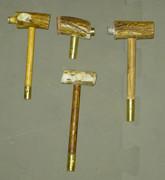Greenhills
Member
- Joined
- Apr 24, 2023
- Messages
- 12
- Reaction score
- 17
Recently moved to PA, and decided to take up black powder to get the benefit of the additional days on the front and back end of the season. Plenty of smokeless experience, none with black powder, but decided to take the plunge and try the full flintlock experience, both because of the after Christmas primitive season and because it looked interesting and fun (And because I finally have a place to shoot on an inexpensive range and a lot of land to walk over, courtesy of my tax bill). Picked up a Traditions Pennsylvania pellet rifle with a .50 bore. The owner’s manual says the rifle can fire either patched round balls or sabots, but decided to start with patched round balls. Initially had a LOT of trouble getting the ball started - it stuck just inside the muzzle, at the point where the rifling starts, so I pulled the ball, fired the blank charge (helpful for experience in pulling a ball and making sure the flint was positioned for proper ignition, but not much else).
Cleaned it and greased it, and then consulted the manual, which recommended that a barrel with cold grease might be hard to load, so I followed the manufacturer’s advice and degreased the barrel prior to firing with alcohol. Loaded the gun successfully one single time, fired it, and then couldn’t reload - same problem, couldn’t get the ball into the grooves. I attributed it to fouling, so I cleaned the barrel, tried to load it.- again, no luck: the ball stuck fast. Pulled it again, fired the blank, punched the tube, tried to reload - same problem.
So after pulling the ball, firing off the charge, and disassembling, cleaning, and greasing the gun, I am somewhat perplexed. I can confirm that the bore was not blocked, and I cleaned it, alternating solvent-impregnated patches and dry white patches until the patches came through white. The bore is .50”, and the balls are .490”; the patches are greased pillow ticking and I am confident that I am not getting two of them. The only idea I have is that I have been punching the tube from the muzzle end when the gun is disassembled, rather from the breech end; is it possible that I am creating an accumulation of gunk in the rifling grooves that prevents ramming? Or is there some other simple solution that I am missing here that the forum could help me with? Any ideas are welcome - I would like very much to progress from noisemaker to rifle……
Cleaned it and greased it, and then consulted the manual, which recommended that a barrel with cold grease might be hard to load, so I followed the manufacturer’s advice and degreased the barrel prior to firing with alcohol. Loaded the gun successfully one single time, fired it, and then couldn’t reload - same problem, couldn’t get the ball into the grooves. I attributed it to fouling, so I cleaned the barrel, tried to load it.- again, no luck: the ball stuck fast. Pulled it again, fired the blank, punched the tube, tried to reload - same problem.
So after pulling the ball, firing off the charge, and disassembling, cleaning, and greasing the gun, I am somewhat perplexed. I can confirm that the bore was not blocked, and I cleaned it, alternating solvent-impregnated patches and dry white patches until the patches came through white. The bore is .50”, and the balls are .490”; the patches are greased pillow ticking and I am confident that I am not getting two of them. The only idea I have is that I have been punching the tube from the muzzle end when the gun is disassembled, rather from the breech end; is it possible that I am creating an accumulation of gunk in the rifling grooves that prevents ramming? Or is there some other simple solution that I am missing here that the forum could help me with? Any ideas are welcome - I would like very much to progress from noisemaker to rifle……






